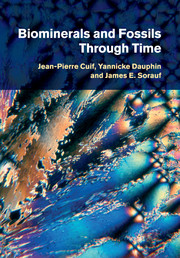Book contents
- Frontmatter
- Contents
- Preface
- Introduction: Milestones in the study of biominerals
- 1 The concept of microstructural sequence exemplified by mollusc shells and coral skeletons
- 2 Compositional data on mollusc shells and coral skeletons
- 3 Origin of microstructural diversity
- 4 Diversity of structural patterns and growth modes in skeletal Ca-carbonate of some plants and animals
- 5 Connecting the Layered Growth and Crystallization model to chemical and physiological approaches
- 6 Microcrystalline and amorphous biominerals in bones, teeth, and siliceous structures
- 7 Collecting better data from the fossil record through the critical analysis of fossilized biominerals
- 8 Results and perspectives
- List of references
- Name index
- Subject index
3 - Origin of microstructural diversity
Facts and conjectures regarding the control of crystallization during skeletogenesis
Published online by Cambridge University Press: 10 January 2011
- Frontmatter
- Contents
- Preface
- Introduction: Milestones in the study of biominerals
- 1 The concept of microstructural sequence exemplified by mollusc shells and coral skeletons
- 2 Compositional data on mollusc shells and coral skeletons
- 3 Origin of microstructural diversity
- 4 Diversity of structural patterns and growth modes in skeletal Ca-carbonate of some plants and animals
- 5 Connecting the Layered Growth and Crystallization model to chemical and physiological approaches
- 6 Microcrystalline and amorphous biominerals in bones, teeth, and siliceous structures
- 7 Collecting better data from the fossil record through the critical analysis of fossilized biominerals
- 8 Results and perspectives
- List of references
- Name index
- Subject index
Summary
Chapters 1 and 2 have established that the microstructural units forming mollusc and coral skeletons exhibit very comparable growth patterns. Coral fibers and mollusc prisms grow by the repeated production of mineralized layers, the thickness of which is in the micrometer range. Clearly, the unit of biomineralization is not the often-described microstructural component that forms each shell layer (prismatic, foliaceous, fibrous, granular, etc.), but rather it is the mineralization cycle that produces the elementary growth layer for each of the different components of the shells or corallites.
From a functional point of view, numerous examples show that distinct mineralized domains are simultaneously produced (e.g., Fig. 1.5i). The growth layer is isochronous, thus, the cyclical mineralizing process is developed on the whole mineralizing surface during the same time period, whatever the differences (microstructural and/or mineralogical) between contiguous mineralizing areas. In the first part of this chapter (Sections 3.1 and 3.2), the structure of the mineralizing growth layer here was investigated in both corals and molluscs, taking advantage of instruments that provide resolutions in the nanometer range. The spatial distribution of organic and mineral components is thus described within the elemental growth layer itself, allowing a functioning model to be inferred. The great similarity revealed by this high-resolution imaging fully confirms the results of the two previous chapters.
However, in contrast to the uniformity which can result from this common growth mode, attention has long been drawn to the potential of skeletal structures for providing information regarding the evolutionary process both in corals and molluscs.
- Type
- Chapter
- Information
- Biominerals and Fossils Through Time , pp. 119 - 184Publisher: Cambridge University PressPrint publication year: 2010

